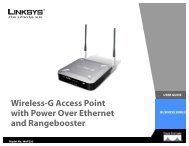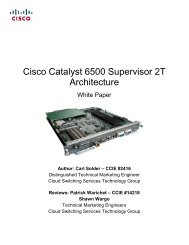Cisco Small Business RV 120W Wireless-N VPN Firewall ...
Cisco Small Business RV 120W Wireless-N VPN Firewall ...
Cisco Small Business RV 120W Wireless-N VPN Firewall ...
You also want an ePaper? Increase the reach of your titles
YUMPU automatically turns print PDFs into web optimized ePapers that Google loves.
Configuring the <strong>Wireless</strong> NetworkConfiguring Advanced <strong>Wireless</strong> Settings3Configuring Advanced <strong>Wireless</strong> SettingsTo configure advanced wireless settings on the <strong>Cisco</strong> <strong>RV</strong><strong>120W</strong>:STEP 1STEP 2STEP 3STEP 4STEP 5STEP 6STEP 7Choose <strong>Wireless</strong> > Advanced Settings.In the Beacon Interval field, enter the time in milliseconds between beacontransmissions. The default interval is 100 milliseconds.In the DTIM Interval field, enter the interval at which the delivery traffic indicationmessage should be sent. A DTIM field is a countdown field informing clients of thenext window for listening to broadcast and multicast messages. When the <strong>Cisco</strong><strong>RV</strong><strong>120W</strong> has buffered broadcast or multicast messages for associated clients, itsends the next DTIM with a DTIM Interval value. Its clients hear the beacons andawaken to receive the broadcast and multicast messages.The default interval is 2beacon intervals.The Request to Send (RTS) Threshold is the packet size, in bytes, that requires theAP to check the transmitting frames to determine if an RTS/Clear to Send (CTS)handshake is required with the receiving client. Using a small value causes RTSpackets to be sent more often, consuming more of the available bandwidth,reducing the apparent throughput of the network packets. The default value is2346, which effectively disables RTS.The Fragmentation Threshold is the maximum length of the frame, in bytes,beyond which packets must be fragmented into two or more frames. Collisionsoccur more often for long frames because while sending them, they occupy thechannel for a longer time. The default value is 2346, which effectively disablesfragmentation. If you experience a high packet error rate, you can slightly increasethe fragmentation threshold; setting the fragmentation threshold too low mayresult in poor network performance. Only minor reduction of the default value isrecommended.Choose the Preamble Mode. The 802.11b standard requires that a preamble beappended to every frame before it is transmitted through the air. The preamblemay be either the traditional “long” preamble, which requires 192 μs fortransmission, or it may be an optional “short” preamble that requires only 96 μs. Along preamble is needed for compatibility with the legacy 802.11 systemsoperating at 1 and 2 Mbps. The default selection is long.Choose the Protection Mode. Select none (the default) to turn off CTS. The CTSto-SelfProtection option enables the CTS-to-Self protection mechanism, which isused to minimize collisions among stations in a mixed 802.11b and 802.11g<strong>Cisco</strong> <strong>RV</strong><strong>120W</strong> Administration Guide 61
















